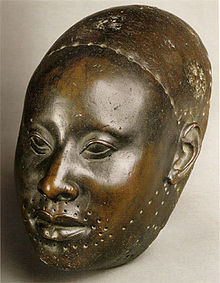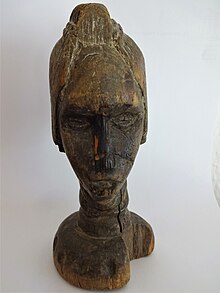African art
African art describes the art of Black Africa , which - like the rest of African culture - differs from the Berber or Arab influenced north of the continent, the states of the Maghreb . African art encompasses the artistic production of many very different ethnic groups . Due to the social structures of Africa , which mainly produced cultural objects made of wood or other natural materials, the climatic conditions and an environment that favor termites and other pests, relatively few historical objects of traditional African art have survived.
Since the artistically designed works of the then colonized continent have only been valued, researched and above all collected in Europe as objects of " authentic cultures " since the beginning of the 20th century , most of the works are in museums and collections both inside and outside Africa and on the art market with a few exceptions not older than 150 years.
Today, outdated, discriminatory-sounding terms such as primitivism , negro sculpture ( Carl Einstein ) or (in France) art negre were affirmative catchphrases of classical modernism , which mainly took the abstracted forms and the exotic aura of African objects as models.
Basic remarks on the western concept of art
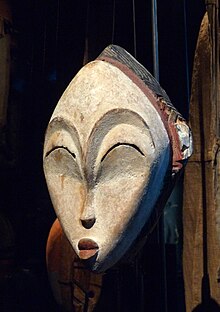
The consideration of " African art" already represents a view that is alien to the respective culture through the bourgeois European concept of art. From the perspective of the people who have produced cultural objects or rites, however, from an ethnological point of view, it is a matter of complex material or non-material ones. material, cultural forms of expression that are ultimately closed to any foreign understanding.
African culture can be examined in two ways: In the case of an internal cultural description, the meaning of the object or the cultural practice is noted from the perspective of the producer or participant ( emic view). If, on the other hand, a conceptual world developed outside of Africa is used, this leads to a projection of the research object onto a foreign perspective (etic observation), where comparisons and evaluations are made based on the aesthetic categories of the observer. However, this projection anticipates the interpretation. There is no such thing as a "culture-neutral" approach.
An example of the different perspectives of perception is the description of masks and the associated rites. These are referred to as means of disguise or disguise in a drama with a magical core, with different symbolic proportions or depending on the culture and within this depending on the type of mask Reality content.
In any case, regardless of the culture's own intention, expressions of material culture are classified under the term African art according to the categories of form, technology, material or place of origin of the most diverse cultures. The viewer's understanding of African art is always subjective.
While anonymous artistic creations were assumed well into the 20th century, more recently their individual traits have been emphasized and the consideration of cultural change has become more important.
Traditional art
The art of the peoples of Africa is firmly connected with mythologies , festivals and rituals : The world of ancestors and gods lives on in this art. Most masks and figures are used as protection against evil forces and diseases. They are worn at harvest festivals or other ceremonial celebrations ( circumcision ritual , celebrations in honor of individual gods, ancestral commemorations, etc.). Some figures are also symbols of fertility .
Preserved objects of artistic design are v. a. Masks and head attachments, ceremonial staffs and staff attachments, thrones and stools (caryatid stools), grave statuettes and ancestral figures, ritual statuettes , fetishes and reliquaries as well as carved doors.
The most important art centers are spread over the following national states:
| Mali | Sculpture of the Dogon and Bamana |
| Guinea | Sculpture of the Baga |
| Burkina Faso | Sculpture of Bobo and Mossi |
| Ivory Coast | Sculpture of Senufo , Dan and Baule |
| Ghana | Sculpture of the Ashanti |
| Nigeria | the ancient art of Nok , Ife, and Benin ; the sculpture of Yoruba , Igbo , Ibibio , Ijo , Ejagham , in the north the art of Jukun , Chamba and Tiv |
| Cameroon | Sculpture of the grasslands ( Bamileke , Bamun ) |
| Gabon | Sculpture of the Fang , Kota , Kwele , Tsogo and Punu-Lumbo |
| Republic of the Congo | Sculpture of Mbochi-Kuyu , Bembe , and Batéké |
| Democratic Republic of the Congo (Zaire) | Sculpture of Bakongo and Yombe , Luba , Songye , Cuba , Luluwa , Pende , Yaka and Lega |
| Angola | Sculpture of the Chokwe |
Early civilizations
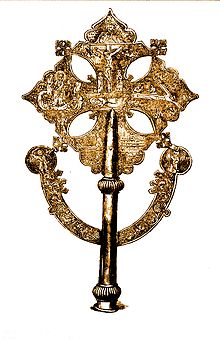
The origins of African art lie in the early history of the continent. Rock carvings in the Sahara ( Niger ) such as the dabous giraffes are around 8,000 years old. The earliest known sculptures come from the Nok culture in Nigeria and were made around 500 BC. The art of ancient Egypt also influenced the design of the objects made south of the Sahara. The abundance of nature was depicted with a simultaneous tendency towards abstraction when depicting animals, plants or natural forms. Around the 13th century, more complex methods of producing art emerged, combined with the spread of Islam and its vocabulary of forms. Cast bronze and brass , often adorned with ivory or precious stones, were valued in much of West Africa. The artists were often active in royal courts such as those of Benin .
West Africa
Sudanese savanna
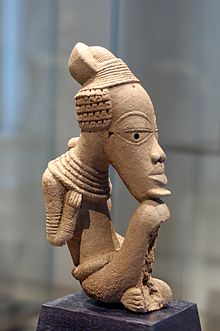

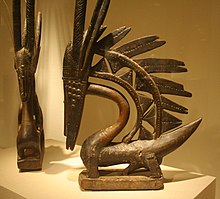
In many regions of Africa where Islamic and European colonizers established their culture, the sculpting traditions of the 19th century and earlier eras have died out. Nevertheless, there are still groups that maintain their traditional rites and make the necessary items. The sculpture west of the Niger can be roughly divided into two large groups: those of the ethnic groups, the Mandé and those who speak a Gur language . The former use the masks primarily for initiation rites and mourning ceremonies . They prefer simple geometric shapes, a T-shaped connection of the nose and brows and high eyes on flat cheeks. With a few exceptions, dark colors are used or the wood is left natural. The surface is often scorched black or decorated with scars that are burned in with a hot blade. Full-figure sculptures consist of cylindrical torsos and arms that are parallel to the upper body and angled forwards.
The masks of the Gur-speaking ethnic groups from Burkina Faso , Togo and Ghana , on the other hand, belong to the families and clans . In addition to initiation and burial rituals, they are also used in dances in which the history of the clan and its members is told. They are designed with black, white and red patterns that are refreshed before each use. Concentric circles around the eyes are striking. Some masks have high, flat boards. There are also horizontal masks depicting characteristics of different animals, as well as carved "hairstyles" that resemble the actual hairstyle of women in the region.
- Regions of Djenné and Ségu
- The region of Djenné in Mali is culturally known today primarily for its Great Mosque , which, along with the clay mosques of Timbuktu, is a World Heritage Site due to its unique clay construction . Even older than this mosque is a culture that existed between the 8th and 17th centuries and left a large number of clay and bronze figures at sites in the Niger Inland Delta . These sculptures almost only depict people or human-like figures, including warriors on horseback, groups of figures, men and women. Some of these figures are covered by snakes , which is why a snake cult is inferred. Mostly they are shown in a kneeling or crouching position. The bronzes were made using the lost wax technique, which was also used to make bracelets, bells , harnesses and pendants.
- As with Djenné, terracottas have also been found in excavation sites near Ségu which, based on thermoluminescence dating from the 14th to 16th centuries . Century. Stylistically, they differ greatly from the finds in Djenné, but the types of figures are similar.
- Dogon
- In the east of Mali and west of Burkina Faso is the ancestral land of the Dogon, which was originally inhabited by the Tellem . Little is known about this early culture, but some sculptures that were found in the niches of the famous adobe buildings of Bandiagara cannot be assigned with any certainty to one or the other group. The wooden masks and ritual objects of the Dogon are particularly known for the detailed depiction of the imaginative mythology of creation . There are carved statues that show the prehistoric being Nommo with raised arms, or those of the son of the god Amma , Dyugu Seru , who covers his eyes because of an incest . Many figures have square ornamental scars on their temples and resemble the terracottas of Djenné, but appear more static. Some sculptures are covered with a crust of sacrificial remains. The Dogon villages and the main settlement area of Bandiagara have been declared UNESCO World Heritage Sites.
- Bambara
- The Bambara or Bamana make up Mali's largest ethnic group with 30% of the total population and belong to the Mandingo Songhai group. In addition to the Dogon , the Bambara created the most important sculptures in the country.
- Mossi
- The Mossi make up 50% of the population of Burkina Faso and, in addition to their carvings, are also known for their textile art, especially weaving and batik . Their culture is based in the Kingdom of Ouagadougou , which existed from the 12th century until the arrival of the French colonizers.
- Bobo
- The Bobo or Bwa live in western Burkina Faso . They are best known for their artistic masks, which have particularly abstract shapes. Carved figures, bronze castings and pottery testify to a diverse handicraft tradition. The very strong colors of the masks are striking: red, white, green, yellow and blue.
- Komo culture
- Gurunsi
- The Gurunsi or Kassena are an ethnic group native to southern Burkina Faso and northern Ghana. In addition to the art of carving, they are known for the elaborate frescoes with which the women decorate their clay buildings. The architecture of the Gurunsi inspired u. a. Le Corbusier .
- Lobi
- The Lobi or Lobi-Dagara migrated from what is now Ghana to their present habitat in the 18th century and now live in southern Burkina Faso. in northern Ghana and the Ivory Coast. Carving art
- Toussiana
- This small group in Burkina Faso practiced both the art of carving and artistic weaving .
The northern and western Guinea coasts
- Soninke
- The Soninke, also called Sarakole, Seraculeh or Serahuli, belong to the Mandé group and come from the Bafourab , and are thus relatives of the Imraguen who live on the Atlantic coast of Mauritania . The Soninke are the founders of the ancient empire of Ghana , which reached its height between the 7th and 10th centuries.
- Baga
- The Baga, which include the Landuman , the Nalu and the actual Baga, live in the Republic of Guinea in the swampy coastal areas and use unusually large masks. The Nimba mask is the most monumental African mask known and can weigh up to 60 kilograms. It represents fertility and is used at harvest time . A huge head with a hook-shaped nose rises above a large, bell- shaped bust , which is sometimes provided with a skirt made of plant fibers. The wearer looks through holes drilled between the breasts and is hidden by the fibers himself. The proportions of the upper body, neck and head as well as the delicacy of the modeling of the ears, nose and other details make it possible to differentiate between different qualities.
- Sapi (Sierra Leone)
- Dan
- The Dan live in the border regions of Ivory Coast and Liberia . There are a very large number of factions belonging to the Dan family. These smaller groups also live in Guinea and Sierra Leone . Carvings , masks and figures
- Boulé or Baule
- Southeast Ivory Coast , carving
- Akan
- The largest Akan people, the Ashanti , founded the Kingdom of the Ashanti : Southeastern Ghana , important goldsmithing , weaving , pottery , wood carving .
- Yoruba
- The Yoruba are by far the largest ethnic group in Africa with a sculptural tradition. This includes not only woodworking, but also ivory carvings , brass works and works made from pearls . The largest masks are the epa masks , which weigh up to 50 kilograms and can reach a height of two meters. Some of the cities where e.g. B. the Owo or the Ife , have been centers of artistic creation for over 700 years. Stylistic similarities with sculptural works of the Nok culture suggest an artistic continuity going back 2500 years.
The eastern Guinea coast
- Nok culture
- The Nok culture in central Nigeria is best known for its impressive terracottas , which are traded for thousands of euros on the art market. The elliptical to triangular eyes, whose pupils are indicated by a recess, are characteristic of the stylized depictions of animals and humans. Individual features such as beards, jewelry and extravagant hairstyles or headgear emphasize the artistic execution of the expressive figures. The rough and grainy surface is due to erosion. The previously smooth engobe coating on the hollow figures is weathered. Only in exceptional cases are the terracottas complete, often only fragments. The Nok figures, dated between 500 BC. BC and AD 200, belong to the oldest figural art in Black Africa.
- More information in the main article: Nok culture
- Igbo
- The Igbo (obsolete Ibo ), over 30 million people, live in Nigeria, mainly in the savannah- interrupted tropical rainforest east of the Niger lower reaches. Her art, including large clay figures on sanctuaries and altars as well as figurative and abstract masks, is mostly in a religious context. In 1938 and 1964 numerous bronze tools and the burial chamber of a high-ranking figure were discovered in the north of the Igbo region (in Igbo-Ukwu) . The richly decorated, superbly crafted bronzes are cast using the lost wax technique . If the dating to the 9th / 10th Century is correct, it is the oldest evidence of the processing of copper and its alloys in West Africa. However, it is not known whether the finds come from the ancestors of the Igbo.
Atlantic Equatorial Africa
The Zaire Basin

East Africa
Contemporary Arts

Since the fringes of the international art scene, referred to as the periphery , have increasingly come to the fore in the western art discourses compared to the known centers, contemporary artists from African countries have also received more attention. Art biennials with international participation take place in Dakar ( Senegal ) and Johannesburg ( South Africa ) . The from Nigeria originating curator Enwezor headed both the 2nd Johannesburg Biennale as the documenta 11 in Kassel .
Some internationally successful contemporary artists from African countries:
- Manuela Sambo (Angola)
- Georges Adéagbo (Benin)
- Eric Adjetey Anang (Ghana)
- Zarina Bhimji (Uganda / Great Britain)
- Bruce Onobrakpeya (Nigeria)
- Mbongeni Buthelezi (South Africa)
- Mo Edoga (Nigeria / Germany)
- Yinka Shonibare (Nigeria / Great Britain)
- Jane Alexander (artist) (South Africa)
- William Kentridge (South Africa)
- Sokari Douglas Camp (Nigeria / Great Britain)
- Didier A. Ahadsi (Togo)
- Cheri Cherin (Dem. Republic of the Congo)
- Meschac Gaba (Benin / Netherlands)
- Dominique Kouas (Bénin)
- Hassan Musa (Sudan / France)
- Bakri Billal (Sudan)
- Ghada Amer (Egypt / USA)
- El Anatsui (Ghana / Nigeria)
- Kwesi Owusu Ankomah (Ghana / Germany)
- Ingrid Mwangi (Kenya / Germany)
- Andries Botha (South Africa)
- Mike Omoighe (Nigeria)
- Zwelethu Mthethwa (South Africa)
- Frédéric Bruly Bouabré (Ivory Coast)
- Marlene Dumas (South Africa / Netherlands)
- Chéri Samba (Democratic Republic of the Congo / France)
- Gilbert G. Groud (Ivory Coast)
- Chidi Kwubiri (Nigeria / Germany)
- Kofi Setordji (Ghana)
- Wanssi Massimo (Ghana)
- Amouzou Glikpa (Togo / Germany / China)
- El Loko (Togo / Ghana / Germany)
materials
African art is as diverse as the materials used for it. Jewelry is a popular form of African art and signals a person's social status, belonging to a group, or it is worn for aesthetic reasons. Traditional materials such as tiger's eye , hematite , sisal , coconut shell , glass beads and ebony are used in the manufacture of the jewelry . Sculptures can be made of wood, ceramic, metal or, like the famous Shona sculptures , natural stone. Pottery is also a widespread craftsmanship in many regions. There are many different textiles in clothing, such as kitenge, mud and Kent fabric.
documentary
- Made in Africa (2014), director and camera: Gert Chesi for the Museum der Völker . The film shows African craftsmen, such as weavers, foundries and potters, who produce for the local market in the traditional way.
applied Arts
Contemporary replicas of utensils and artifacts similar to traditional art in large numbers that are sold as souvenirs are considered Airport Art . In addition, handicrafts for everyday use such as furniture, household items, fabrics and clothing, jewelry or design objects have always been made in Africa. Body decorations such as tattoos or deliberately created scars occupy a special position, which can often be traced back to traditional notions of belonging to certain groups of people, ethnicities, etc.
Museums and collections of African art
In Europe and America:
- Ethnological Museum , Berlin
- Linden Museum , Stuttgart
- Museum Five Continents , Munich
- Museum of Ethnology in Leipzig
- Museum am Rothenbaum, Hamburg
- Rautenstrauch-Joest-Museum - Cultures of the World , Cologne
- Weltkulturen Museum , Frankfurt am Main
- Barbier-Mueller Museum , Geneva
- Museum Rietberg , Zurich
- IWALEWA house , Bayreuth
- Quai Branly Museum , Paris
- Africa Museum, Berg en Dal , Netherlands
- Royal Museum for Central Africa , Tervueren, Belgium
- World Museum Vienna
- Museum of the Nations , Schwaz, Tyrol, Austria
- Metropolitan Museum of Art , New York
- National Museum of African Art , Washington DC
In Africa:
- Musée des civilizations noires , Dakar, Senegal
- National Museum Nairobi , Kenya
- National Museum of the Democratic Republic of the Congo , Kinshasa
- Johannesburg Art Gallery , Johannesburg
- Zeitz Museum of Contemporary Art Africa , Cape Town, South Africa
See also
- List of African painters
- UNESCO World Heritage List (Africa)
- Report on the restitution of African cultural assets
- Kingdom of Benin
- Ashanti Empire
- Cuba Federation
- Nok culture
- Master of Buli
literature
- Stefan Eisenhofer , Karin Guggeis: African Art. Facts, prices, trends. Deutscher Kunstverlag, Munich 2002, ISBN 3-422-06335-8 .
- Till Förster: Art in Africa. DuMont, Cologne 1988, ISBN 3-7701-1899-5 .
- Hans Himmelträger : African masks. A breviary. Klinkhardt & Biermann, Braunschweig 1960.
- Pierre Meauzé: African sculpture. Appearance, development, connections. Bussesche Verlagshandlung, Herford 1969.
- Sabine Hollburg, Gereon Sievernich (Red.): Modern art from Africa. An exhibition (June 24th - August 12th 1979) as part of the first festival Horizonte - Festival of World Cultures in West Berlin. Berliner Festspiele, Berlin 1979, ISBN 3-922351-00-X .
- Dmitrij Olderogge (text), Werner Forman (photographs): African art. From the Africa collections of the Museum of Anthropology and Ethnography, Leningrad. Dausien, Hanau 1984.
- Peter Probst Osogbo and the Art of Heritage. Monuments, Deities, and Money. Indiana University Press, Bloomington et al. 2011, ISBN 978-0-253-22295-4 .
- Sebastian Stein: Every look reveals its location. Perspectives on art from Africa. In: iz3w. No. 311, March / April 2009, ISSN 0933-7733 , pp. 42-44.
- Ingrid Thurner: Art as a fetish. On the western reception of African objects. In: Communications from the Anthropological Society in Vienna. Vol. 127, 1997, ISSN 0373-5656 , pp. 79-97.
Web links
- Picture gallery of the exhibition “Africa remix. Contemporary art of a continent "in the museum kunst palast, Düsseldorf (2004)
- “Walter Bareiss, 87, dies; Specialist in African Art " , The New York Times , April 27, 2007
- African Art from the Democratic Republic of the Congo (Lega)
- Iwalewa House Bayreuth
- Africa Museum Berg en Dal near Nijmegen / Netherlands
- Royal Museum for Central Africa-Tervueren / Brussels
- Rautenstrauch-Joest-Museum for non-European art and culture Cologne
Individual evidence
- ^ Till Förster: Art in Africa . DuMont, Cologne 1988, pp. 10-33.
- ↑ Rainer Greschik , Nils Seethaler : Preface. In: Lobi. West African sculptures from the Greschik collection. Published on the occasion of the exhibition “The Discovery of the Individual” in Lutherstadt Wittenberg, 2016.
- ↑ Peter Breunig (Ed.): Nok. An origin of African sculpture. Africa Magna, Frankfurt am Main 2013, ISBN 978-3-937248-38-7 .
- ↑ Contemporary African Art - Kouas . gedichte-brie.de. August 29, 2003. Retrieved August 18, 2010.
- ^ Contemporary African Art - Bakri Billal . Gedichte-brie.de. Retrieved August 18, 2010.
- ↑ Edmund Leach : Culture and Communication - To the logic of symbolic connections . Suhrkamp Taschenbuch Verlag, Frankfurt am Main 1978, p. 69-80 .
- ↑ Made in Africa trailer at: vimeo.com

